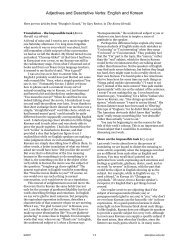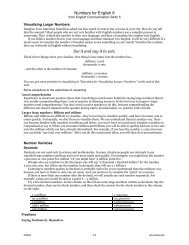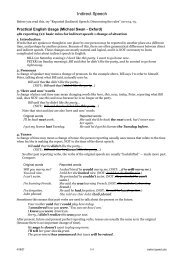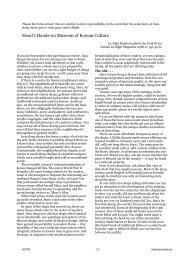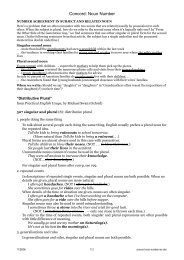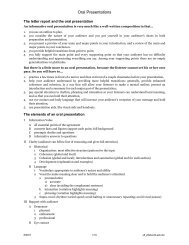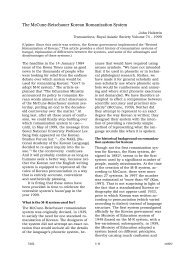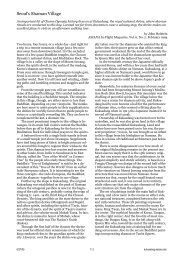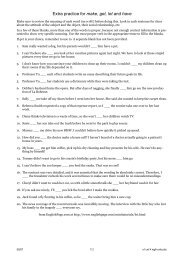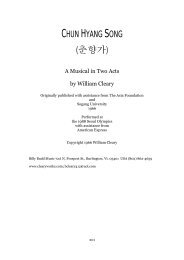THE MONEY BUG - Korea Mosaic
THE MONEY BUG - Korea Mosaic
THE MONEY BUG - Korea Mosaic
You also want an ePaper? Increase the reach of your titles
YUMPU automatically turns print PDFs into web optimized ePapers that Google loves.
Several scholars have expressed opinions on the evolution of this story; 7 even a brief summary of<br />
each opinion would take up too much space, so it might be better to simply present a chronological<br />
arrangement of documented tales that may have influenced our tale. Generally, then, the first tale is a<br />
third century B.C. Buddhist jataka; its next appearance is in a Chinese translation of the Mahayana<br />
sutras; we find a similar story later in <strong>Korea</strong> in a story about a legend in the Koryo’ dynasty (890 –<br />
1392 A.D.), another in the sixteenth century, yet another in the seventeenth century, and find the<br />
fully developed story in eighteenth-century pansori and nineteenth-century pansori novella. Our<br />
story began with a rich, mean miser and an imposter, picked up a straw man here and a Taoist immortal<br />
there, flavored it with references to Chinese literature and mythology, and ended up with a lot<br />
more than a simple jataka tale.<br />
In the oldest known story, the jataka The Miserly Treasurer, 8 the deceased father of the wealthy<br />
and compassionless miser Illisa came back in the form of his son in order to reform the son. He convinced<br />
everyone that he was Illisa; the real Illisa was chased away, and the imposter gave away all Illisa’s<br />
money to the poor. Illisa’s father told the king what he did and why, the king threatened Illisa<br />
with death if he didn’t reform, Illisa did reform, and lived the rest of his life as a model Buddhist.<br />
The Koryo dynasty story is about Gyeong, another rich miser, who treated a monk badly when the<br />
monk asked for some rice. 9 The monk then approached Kim, a neighbor, who treated the monk with<br />
kindness. After the monk left, Kim found an old man in the room where the monk had rested, and the<br />
old man gave Kim enough treasures to make him very wealthy. Gyeong found out about this, then got<br />
the monk to send the old man to his room too. But the person that Gyeong found waiting in his room<br />
looked just like himself, and claimed ownership of Gyeong’s estate. The imposter (after convincing<br />
family, neighbors and authorities) succeeded in getting Gyeong evicted, and then gave away all of<br />
Gyeong’s wealth to the poor. Then the monk showed up, hit the phony Gyeong with his walking stick,<br />
the phony turned into a bundle of straw, and the monk disappeared into thin air. (In The Gourds’<br />
Rewards, Nolbu, jealous of Hungbu’s reward, tried to trick Heaven and eventually got his own reward,<br />
especially tailored to match his dirty deed. This similarity in the two stories is a good example<br />
of how, in oral literature, different stories’ elements get exchanged over centuries of transmission,<br />
resulting in many different versions.)<br />
There is a record from the sixteenth century 10 of a long and complex incident of one brother’s disappearance<br />
and an imposter’s later claim to be that person; when he is found out he is taken off to<br />
A Yang for Every Yin 168




